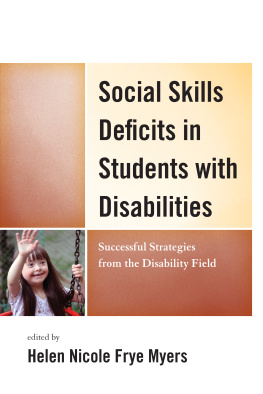WOMEN AND DISABILITY
First published 1985 by Transaction Publishers
Published 2017 by Routledge
2 Park Square, Milton Park, Abingdon, Oxon, 0X14 4RN
711 Third Avenue, New York, NY 10017, USA
Routledge is an imprint of the Taylor & Francis Group, an informa business Copyright 1985 by Taylor & Francis.
Copyright 1985 by Taylor & Francis.
All rights reserved. No part of this book may be reprinted or reproduced or utilised in any form or by any electronic, mechanical, or other means, now known or hereafter invented, including photocopying and recording, or in any information storage or retrieval system, without permission in writing from the publishers.
Notice:
Product or corporate names may be trademarks or registered trademarks, and are used only for identification and explanation without intent to infringe.
Library of Congress Catalog Number: 84-2618
Library of Congress Cataloging in Publication Data
Main entry under title:
Women and disability.
1. Physically handicapped womenAddresses, essays, lectures. 2. Discrimination against womenAddresses, essays, lectures. I. Deegan, Mary Jo, 1946- . II. Brooks, Nancy A., 1943-
HV3021. W66W66 1985 362.4'088042 84-2618
ISBN 0-88738-017-4
ISBN 13: 978-0-88738-017-4 (hbk)
A significant number of chapters in this book first appeared in The Journal of Sociology and Social Welfare, Vol. VIII, No. 2, July 1983, pp. 233-375. This includes the chapters by Fine and Asch, Becker and Jauregui, Kolb, Deegan, Kutza, Kutner and Gray, Saxton, McCharen and Earp, and Shaul, Dowling, and Laden. We thank the journal staff for their support and interest in this project.
Most of the chapters previously published have been revised, reedited, and somewhat altered for the present volume.
To
MARJORIE STAMM
and
JOHN BROOKS
Rose Lynn Sherr and Beatrice A. Wright
This volume opens up a new area in the literature concerning disability. The seriousness of the lack of recognition of the special needs of women who have disabilities comes through time and again as one reads the various chapters. Some of the chapters provide new levels of understanding and analysis, and some point the way to profitable areas of research. As a col-lection, this volume makes obvious the need for intervention in the political, social, psychological, and medical domains. In their correspondence with us the editors had noted that, conforming to the requirements of scientific writing, the material was presented nonemotionally. Yet as we read the book, we were shaken and astounded by it.
Our astonishment was due partially to a growing awareness of our own oblivion to the issues presented. Despite our long professional involvement in the field of rehabilitation psychology and our appreciation of a feminist viewpoint, we had been remarkably unaware of the unique issues of women with disabilities. Clearly, we are not alone. The authors provide impressive evidence of the dearth of recognition of these issues by investigators, program planners, clinicans, and most of the world.
Thus, beyond the obvious contribution of the book to the professional literature, an even greater value may lie in its potential for raising the consciousness of its readers to the special status of women with disabilities as a minority group experiencing multiple sources and forms of discrimination. The importance of this consciousness-raising applies to persons involved in making public policy and to the academic and professional rehabilitation communities. It applies to women and men with disabilities. It applies to society as a whole.
The heightened consciousness is essential because the special needs of women with disabilities have been disregarded in a wide variety of vital areas. Consider issues pertaining to women as wives and mothers. What is needed are women with disabilities to serve as role models, but the social support systems traditionally available to women concern problems of able-bodied women in general, not the special problems of women who have disabilities. Although the womens movement has provided additional role supports for women, it also has not been concerned with the special needs of women with disabilities. It is encouraging to learn from the chapters presented in this volume that there have been beginnings of networks and support systems for women with disabilities to deal with various aspects of living.
In the area of health, the volume convincingly documents the notable lack in the medical literature of studies of pregnancy among women who have specific disabilities. Also lacking are studies of the effects on female sexuality of such conditions as renal disease and diabetes, although the sexual functioning of men with these diseases has been researched. Similarly, the effects on male sexual functioning of medication to control hypertension are recognized, but not the effects on womens sexual functioning.
On the economic front, the social structures established on behalf of people who have a disability have not taken into account the fact that women have traditionally been disadvantaged in the marketplace by sex stereotypes and depressed earnings. The programs, therefore, have not seriously considered the particular circumstances of women with disabilities. Consequently, the Federal-State Vocational Rehabilitation System and the regulations concerning disability benefits under Social Security provide less adequately for women than for men.
The past 20 years have brought increased awareness of the special issues concerning various disadvantaged groups, including racial and ethnic minorities, people with disabilities, women, and older persons. The result has been the occurrence of notable changes in policy and practice on the part of government and the private sector to redress legitimate grievances, and changes in research and technical orientation. The present volume promises to catalyze a similar advance with regard to women with disabilities.
Physically disabled women are a population close to the minds and hearts of the editors and authors of this text. In one form or another, we have felt the effects of discrimination and stigmatization on the lives of disabled women whom we have loved and admired. This book, then, is not a dispassionate analysis of yet another social problem but a reflection of a lived reality that we know well. It is with great joy and a sense of achievement that we are able to participate in the writing and editing of this collective task.
As editors we have the privilege of singling out not only the chapter contributors but others whose work is less visible but nonetheless vital. We owe special thanks to Norman Goroff, a former editor of The Journal of Sociology and Social Welfare. He introduced the editors to each other and encouraged us to work together for a special issue of the journal. After a rather slow start, we found that we did, indeed, share a number of mutual interests. During a series of telephone conversations, we decided on this topic of physically disabled women. Bob Leighninger, who succeeded Norman Goroff as the editor of the journal, continued the good spirit and support of his predecessor. Both of us have received support from our respective Deans who supplied us with funds for advertisements, mailing, xeroxing, and telephone calls. Therefore, we give a special note of thanks to Max Larsen, the former Dean of Arts and Sciences at the University of Nebraska-Lincoln and to Lloyd Benningfield, the Dean of the Graduate School at Wichita State University. The Nebraska Research Council generously provided the funds needed for the final preparation of the mansucript. This support came at a crucial point in the manuscript process enabling us to spend more time on the content of the work rather than its physical production. Michael R. Hill, Laurie Workman Eelis, and Sharon Selvage entered the manuscript on the computer, and they are heartily thanked for their great service, support, and constructive criticisms. We would also like to thank Margaret Zahn for supplying us with the names of sociologists who were members of the subsection on disability in the American Sociological Associations medical section. The following individuals also served as reviewers of the manuscripts; their aid and knowledge were invaluable: Gary Albrecht, Elwin Barrett, Jane Bogel, Thomasina Borkman, Kathy Brezinski-Stein, JoAnne Brockway, Jean Cole, Judith K. Coryell, Nancy Crewe, Cheryl Davis, Nancy Erikson, Walda Katz Fishman, John Freal, Lex Frieden, Jan Fritz, Margaret Gardner, Lesley Hoyt, Mary Ann Lamana, Jerry Lorenz, Scott Manley, Susan Martina, Bemie Mermis, Sheila Miller, Hyman Miriam-Polaski, Helen Moore, Marcia Pavlov, Judy Plaskow, Constantina Safilios-Rothschild, Mary Kay Schleiter, Lois Schwab, Susan Shaul, Joanne Taggie, Dorothy Walters, Harold Wilke, Be-atrice Wright, Margaret Zahn, and Irving Zola.






